Stem Cell Transplant Program
Patient Journey
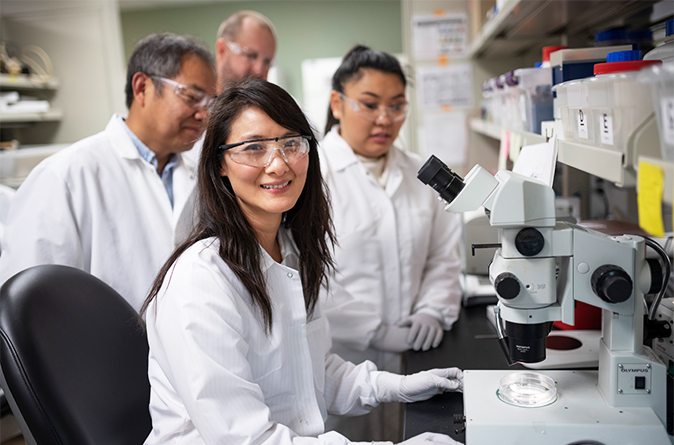
We understand that a stem cell or cord blood transplant is a major decision, impacting you and your loved ones. It's also a chance for renewed health. We will guide you through the transplant process, empowering you to make informed choices throughout your journey.
You will not be alone. Your dedicated UC Davis Health team will be by your side, including doctors, nurses, coordinators, social workers and other specialists. At every stage, they will work to ensure the best possible outcome for you.
Your primary oncologist will refer you to the transplant team for consultation.
During the first visit you will meet with a physician, nurse coordinator, nurse practitioner and social worker to evaluate your medical condition and determine your eligibility for a stem cell transplant. You will be asked about your medical history, social support, transportation and any other challenges you may face.
A physical examination and a variety of lab tests may be performed. The transplant team will explain the benefits and risks of a stem cell transplant and give you an overview of what to expect. You may also be given the option of participating in a stem cell clinical trial, which evaluates promising new treatments.
You will also be evaluated for your access to a strong support network. Bring one or more individuals who can provide support to you at your first appointment. You will need to designate a caregiver such as a responsible family member and/or friend who can provide physical care, emotional support, and transportation during and after your transplant.
Support is key
A strong support network is essential for a stem cell transplant to be successful. It is important to have at least one caregiver—such as a responsible family member or friend—who can provide physical care, emotional support and transportation during and after your transplant. Please bring your support person(s) to your first appointment.
A financial coordinator will obtain information about your insurance coverage. If you do not have adequate insurance, you may be eligible for financial assistance. Even with insurance coverage, the costs associated with a transplant can be significant. Our social workers will provide you with information about resources that can help relieve the financial burden associated with a transplant.
If a transplant is considered a good option for you, you will undergo medical tests to assure you are well enough for the procedure. The tests will include a chest X- ray and EKG. The functioning of your lungs, liver, kidney and heart will also be evaluated. You will also undergo infectious disease and dental screenings
After the pre-transplant evaluation, you will visit the transplant physician to review test results and determine whether a transplant is appropriate. If so, your insurance company will be asked to authorize the stem cell donor search (if needed), collection and transplant process.
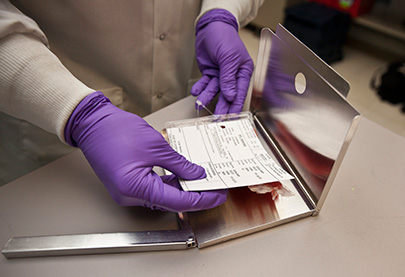
Your transplant physician will decide what type of a transplant should be done and determine the stem cell source.
- For an autologous transplant, you will donate your own peripheral blood stem cells.
- For an allogeneic transplant, the transplant physician and nurse coordinator will work with you and your family to identify a suitable stem cell donor, ideally a genetically matched brother or sister. If you don’t have a match in your family, a search for an unrelated matched adult donor or an umbilical cord stem-cell donor will be initiated through the National Marrow Donor Program.
You and your caregiver(s) will meet with the transplant nurse coordinator for a two-hour educational session to learn more about the transplant process including:
- Self-care and precautions to protect your health after leaving the hospital to prevent infection and activities to support your recovery.
- Foods to avoid and adherence to a low microbial diet, which are foods less likely to contain harmful bacteria.
- Signs and symptoms to watch for after hospital discharge.
All patients will have a catheter (a long, flexible tube often called a central line), placed in the chest. The catheter is used to give chemotherapy, medications, intravenous fluids, blood products, collect blood for lab work and to infuse stem cells. If you are donating stem cells for yourself, the catheter will allow stem cell collection without inserting needles into your arm.
For autologous patients, the catheter is placed prior to stem cell mobilization and collection (see below). For allogeneic patients the catheter is placed prior to hospital admission.
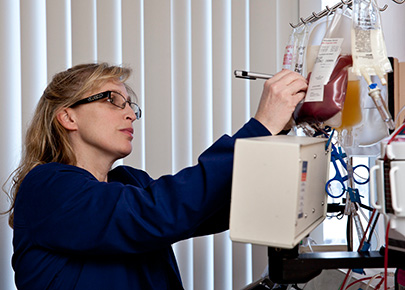
In an autologous transplant, you will donate your own stem cells present in the blood stream.
You or your caregiver will be trained to inject a daily medication called Neupogen (or GCS-F), and in some cases, an additional medication called Mozobil, for a few days before collection starts. These medications make your bone marrow produce and release a large number of stem cells into the bloodstream. The process is known as “mobilization.” You may also undergo chemotherapy. Your transplant physician will determine your specific treatment.
During the stem cell collection, you will be connected to an apheresis machine via your catheter. Blood will circulate through the machine, collecting stem cells and returning the rest of the blood to you. Each collection session takes approximately six to eight hours. Typically, it takes one to five days to collect enough stem cells for a transplant. The apheresis procedure is usually well-tolerated and the side effects are minimal.
You will be notified of your stem cell count each evening to determine whether you need additional injections of Neupogen and/or Mozobil and an additional collection the following day. The stem-cell collection will continue until the targeted number of stem cells is reached.
After stem cell collection, you will have several weeks to rest and recover before being admitted to the hospital for treatment and transplant.
Learn more: Collection of stem cells in allogeneic transplants
Collected cells will be processed, cryopreserved and stored in liquid nitrogen tanks, at a very low temperature of approximately –189°C (-308°F) at the Hematopoietic Progenitor Cell Laboratory at the cancer center. On the day of the transplant the laboratory staff will transport the frozen cells to the Bone Marrow Transplant Unit.
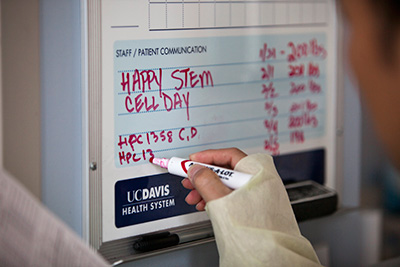
You will be admitted to the Bone Marrow Transplant Unit (BMTU) on Davis Tower 8 and stay in a private room with your own bathroom. Your room will have a special ventilation system to assure the air is clean.
You will remain in the room during most of your stay, only leaving for physician-approved studies. This policy is designed to protect you from infection. We provide some exercise equipment in your room and encourage you to be out of bed as much as possible.
You will have diet restrictions and will be on a low microbial diet. Our dieticians will educate you on what kind of food you or your family can bring from home.
Visitors are allowed but restricted to guests over age 16 years. People who are ill are not allowed to visit. For your visitor's convenience, a shower, a bathroom and a waiting area are located on the Bone Marrow Transplant Unit.
Your daily routine as a stem cell transplant patient will consist of physician and/or nurse practitioner assessments, laboratory results analysis, shower, medication administration, frequent oral hygiene, vital signs and nursing assessments. If you are medically stable, we will minimize interruptions to your sleep after 10 p.m. (the usual blood draw time). You will be connected to a continuously infusing I.V. line for the majority of your stay, but we encourage you to be as active as possible while you are here and to get out of bed most of the day. This schedule may vary depending on how you are progressing through your transplant. Please ask questions and let us know if you are having symptoms or concerns. The nurse, physicians, and other staff are here to help make your hospital stay as safe and comfortable as possible.
Diet and water safety information
We encourage you to bring activities from home such as books, small electronics, and laptops. The unit has a refrigerator, freezer and microwave so that you may bring a small amount of food from home to store for your use while you are here. Some patients bring comfortable pajamas, familiar objects and pictures from home, electric razors, and other small items for their comfort. Please do not bring large electronics such as TV's, game consoles, large amounts of perishable foods, blenders, coffee makers, toothbrushes, floss, or disposable razors. We provide some alternatives and want to assure your safety. Fresh flowers and restaurant-prepared foods are restricted due to your weakened immune system.
You will receive conditioning treatment in a single day or in divided doses over a several days. Autologous transplant patients or younger patients receive a very high dose of chemotherapy with or without radiation. This type of conditioning is called myeloablative treatment. In certain situations, particularly in patients over 50 or 60 having an allogeneic transplant, lower-dose, less toxic chemotherapy and radiation are used in what is called a reduced-intensity or a non-myeloablative treatment.
The conditioning treatment will destroy cancer cells in your body and suppress your immune system to lower the chance of stem-cell rejection.
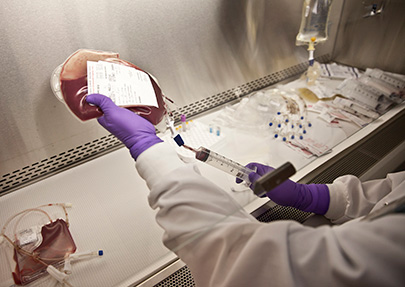
Prior to the infusion, you will be given medications to reduce side effects and intravenous fluids for hydration. You will be awake during the infusion, although you might be mildly sedated from the medications given to prevent an allergic reaction.
If you are receiving cells that were frozen following the collection, Progenitor Cell Laboratory staff will transport the bags with these cells in a dry shipper to the Bone Marrow Transplant Unit. The bags will be thawed one at a time in a warm water bath.
If you are receiving cells donated by an unrelated donor, the cells most likely will be infused “fresh” (without undergoing freezing after collection) within 48 hours after the collection. Cells donated by your matched sibling will be also infused “fresh.”
The infusion of stem cells lasts between 30 minutes and three hours depending on the volume of stem cells.
The cells will be infused through a catheter inserted into the large vein in your chest. The procedure is similar to receiving a blood transfusion. During the infusion of the new cells your nurse will monitor you very closely and respond to any reactions.
Side effects are usually mild and can be reduced with medication. During infusion of previously frozen stem cells, you may also notice a garlic-like smell and taste, the result of a chemical called DMSO added during freezing. A popsicle can be provided to decrease the taste.
Engraftment is when stem cells begin to grow and produce new red blood cells, white blood cells and platelets. The days following the transplant and before engraftment are the most critical. The high doses of chemotherapy and radiation destroy the bone marrow, leaving you with no white blood cells, decreased red blood cells and very few platelets. During this time, you are susceptible to potentially life-threatening infections, which is why you will receive preventive antibiotics.
You will feel extremely tired, weak and sick. Whether the stem cells you received were from a sibling or unrelated donor, you may develop graft versus host disease (GVHD) that cause the transplanted cells (graft) to recognize the patient’s body (host) as foreign and attack it.
This complication can develop within a few weeks of the transplant (acute GVHD) or much later (chronic GVHD). To prevent this complication you may receive medications to suppress your immune system.
Engraftment usually occurs within two to four weeks after the infusion. Even though the blood counts return to normal, it takes much longer for your immune system to completely recover – several months if you received your own cells, and one or two years if you received cells from a donor.
The team of doctors, nurse practitioners and nurses will closely monitor you for side effects and complications and give you medications to treat these symptoms. You will get blood transfusions of platelets to prevent bleeding and red blood cells to treat anemia, and possible growth factors to help your body make more white blood cells.
The length of hospitalization after a stem cell transplant varies, depending on the transplant type, your response and other factors. You will be discharged from the hospital based on your health status after your blood counts are stable and sufficient, and any side effects of the treatment are controlled with oral medications. Before you go home, your nurse, physician or nurse practitioner will review discharge instructions with you and your caregiver(s). Staff will also go over your discharge medications with you at this time. You will continue a low microbial diet at home as instructed by your dietician.
After your hospital discharge, you will continue your recovery at home or, if you live far away from the hospital, at lodging near the UC Davis Medical Center.
You will feel weak and tired, and your immune system will still not be able to fully protect you from infections. Since you will remain at risk for post-transplant complications, you will need to watch for early signs and symptoms of infection and quickly report them to your transplant doctor. You may have to return to the hospital for treatment, if needed. It will be very important that you focus on recovery, regaining your strength and energy, eating well, avoiding infections, taking your medications regularly and coming to the appointments with your transplant team. It can take many months and sometimes years for your immune system to rebuild and fully protect you again.
You and your caregiver play an important role during the recovery period. You will need to follow guidelines and orders provided by the transplant team. For allogeneic transplant patients, especially, you will take many medications and have frequent blood tests. It is important for a caregiver to be involved and help you “stay on track” with the complicated regimen.
If you have questions during your recovery process, call your transplant nurse coordinator.
During the initial recovery period your transplant team will follow you closely. During each appointment you will be evaluated for any infections or other complications. You will be scheduled for blood draws, X-rays, possible bone marrow biopsies or other tests to monitor your recovery. You may also need blood transfusions or intravenous fluid replacement.
The follow-up care by your transplant team will continue until post-transplant complications are resolved. Alert your doctor and transplant nurse coordinator to any problems you are experiencing.
Your care will eventually be transferred to your referring oncologist. The transfer usually occurs about two months after an autologous transplant and six or more months after an allogeneic transplant.

